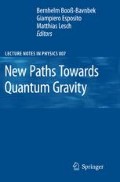Abstract
The aim of these lectures is a short introduction into some recent developments in stochastic geometry which have one of its origins in simplicial gravity theory (see Regge Nuovo Cimento 19: 558–571, 1961). The aim is to define and construct rigorously point processes on spaces of Euclidean simplices in such a way that the configurations of these simplices are simplicial complexes. The main interest then is concentrated on their curvature properties. We illustrate certain basic ideas from a mathematical point of view. An excellent representation of this area can be found in Schneider and Weil (Stochastic and Integral Geometry, Springer, Berlin, 2008. German edition: Stochastische Geometrie, Teubner, 2000). In Ambjørn et al. (Quantum Geometry Cambridge University Press, Cambridge, 1997) you find a beautiful account from the physical point of view. More recent developments in this direction can be found in Ambjørn et al. (“Quantum gravity as sum over spacetimes”, Lect. Notes Phys. 807. Springer, Heidelberg, 2010). After an informal axiomatic introduction into the conceptual foundations of Regge's approach the first lecture recalls the concepts and notations used. It presents the fundamental zero-infinity law of stochastic geometry and the construction of cluster processes based on it. The second lecture presents the main mathematical object, i.e. Poisson–Delaunay surfaces possessing an intrinsic random metric structure. The third and fourth lectures discuss their ergodic behaviour and present the two-dimensional Regge model of pure simplicial quantum gravity. We terminate with the formulation of basic open problems. Proofs are given in detail only in a few cases. In general the main ideas are developed. Sufficiently complete references are given.
In Erinnerung an Herbert Ziezold
Based on lectures held at the Instituto de cibernetica, matematica y fisica (ICIMAF), La Habana (Cuba), in March 2006.
Access this chapter
Tax calculation will be finalised at checkout
Purchases are for personal use only
References
J. Ambjørn, “Quantization of Geometry”, in: J. Dalibard, J.M. Raimond, J. Zinn-Justin, (eds.), Les Houches, Session LIII, 1990. Systemes Fondamentaux en Optique Quantique/Fundamental Systems in Quantum Optics. Elsevier Science Publishers B.V. (1995).
J. Ambjørn, B. Durhuus, T. Jonsson, Quantum Geometry, Cambridge University Press, Cambridge (1997).
J. Ambjørn, J. Jurkiewicz, R. Loll, “Quantum gravity as sum over spacetimes”, Lect. Notes Phys. 807. Springer, Heidelberg (2010).
B. Delaunay, Sur la sphére vide, Bull. Acad. Sci. URSS VI, Class. Sci. Math. Nat., 793–800 (1934).
O. Kaiser, Das ergodische Verhalten der Lipschitz-Killing-Krümmung stationärer Thurston-Prozesse, Diplomarbeit, Universität Bielefeld (2008).
K. Krickeberg, Processus ponctuels en statistique, École d’été de St. Flour X-1980, Lect. Notes Math 929, (1982) 206–313.
V.A. Malyshev. Probability related to quantum gravity. Planar gravity, Russ. Math. Survey 54 (4), (1999) 685–728.
V.A. Malyshev. A.A. Yambartsev, A.A. Zamyatin, Two-dimensional Lorentzian models, Moscow Math. Journ. 1 (3), (2001) 439–456.
K.M. Matzutt, Konstruktion zufälliger, lokal endlicher Mosaike, insbesondere Laguerrescher, Diplomarbeit, Universität Bielefeld (2006).
J. Mecke, Stationäre zufällige Maße auf lokalkompakten Abelschen Gruppen, Z. Wahrscheinlichkeitstheorie verw. Gebiete 9, (1967) 36–58.
M.G. Mürmann, Poisson point processes with exclusions, Z. Wahrscheinlichkeitstheorie verw. Gebiete 43, (1978) 23–37.
X.X. Nguyen, H. Zessin, Punktprozesse mit Wechselwirkung, Z. Wahrscheinlichkeitstheorie verw. Gebiete 37, (1976) 91–126.
T. Regge, General relativity without coordinates, Nuovo Cimento 19, (1961) 558–571.
Yu.G. Reshetnyak, Two-dimensional manifolds of bounded curvature, in: Reshetnyak, Yu.G. (ed.), Geometry IV, Encyclopaedia of Mathematical Sciences, vol. 70, Springer, Berlin (1993).
B.D. Ripley, Locally finite random sets: Foundations for point process theory, Annals of Probability 4, (1976) 983–994.
R. Schneider, W. Weil, Stochastic and Integral Geometry, Springer, Berlin (2008). German edition: Stochastische Geometrie, Teubner, Stuttgart (2000).
W.P. Thurston, The geometry and topology of three manifolds, Electronic version 1.1, http://www.msri.org/publications/books/gt3m/ (2002).
H. Zessin, Specific index and curvature of random simplicial complexes, Izv. Nats. Akad. Nauk Armenii Mat. 37(1), (2002) 70–88.
H. Zessin, The Thurston Process, Preprint Nr. 171, FSPM, University of Bielefeld, Germany (2005).
H. Zessin, The Gauß-Bonnet theorem for stationary simplicial complexes, Izv. Nats. Akad. Nauk Armenii Mat. 38 (3), (2003) 75–82.
Acknowledgements
I am grateful to Otto Kaiser and Kai Matzutt for several illuminating discussions. I also thank the referee for his remarks which led to a substantial improvement of this chapter.
Author information
Authors and Affiliations
Corresponding author
Editor information
Editors and Affiliations
Rights and permissions
Copyright information
© 2010 Springer-Verlag Berlin Heidelberg
About this chapter
Cite this chapter
Zessin, H. (2010). Stochastic Geometry and Quantum Gravity: Some Rigorous Results. In: Booß-Bavnbek, B., Esposito, G., Lesch, M. (eds) New Paths Towards Quantum Gravity. Lecture Notes in Physics, vol 807. Springer, Berlin, Heidelberg. https://doi.org/10.1007/978-3-642-11897-5_6
Download citation
DOI: https://doi.org/10.1007/978-3-642-11897-5_6
Published:
Publisher Name: Springer, Berlin, Heidelberg
Print ISBN: 978-3-642-11896-8
Online ISBN: 978-3-642-11897-5
eBook Packages: Physics and AstronomyPhysics and Astronomy (R0)

